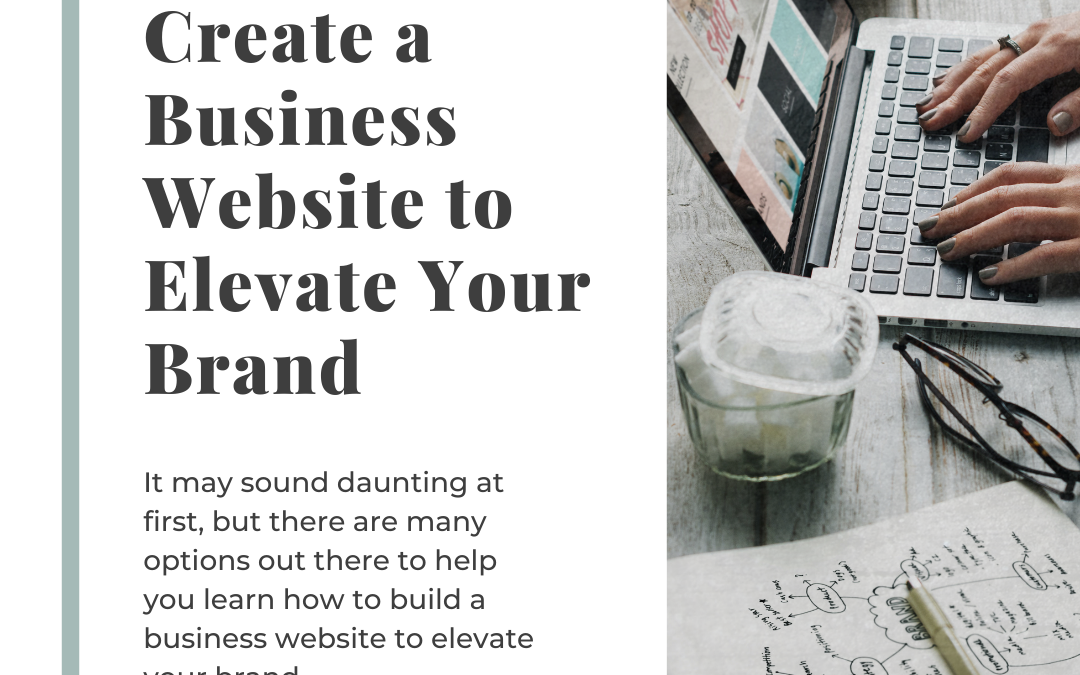Along with the Covid-19 pandemic came the migration of businesses online. No matter your sector or industry, with people staying home and subsequently getting used to being able to access their favorite businesses online at any time, it has become essential to elevate your brand with a beautiful, functional, and well-optimized business website. Businesses large and small all have found it necessary to not only be online but to have a recognizable brand that speaks to potential customers where they are — and odds are they are searching for your products or services on their mobile devices. This has many small business owners and marketers wondering how to create a business website.
Companies typically take one of two routes to create a business website. Either your company opts to hire a web designer/developer to build a website for you, or someone at your business creates the site in-house. For many solopreneurs, this may fall on your plate, as well as everything else that comes along with running a small business. It may sound daunting at first, but there are many options out there to help you build a business website to elevate your brand.
If you’re looking for a how-to on starting your own business, check here first!
Building a Small Business Website Step-by-Step
1. Register Your Domain Name
I recommend Bluehost for purchasing your domain and hosting. Simply head over to Bluehosts’ domains page and search to see if your desired domain is available. If your first choice of domains is not available, don’t worry, the tool will suggest some alternatives for you.
Most often, a small business will go with their business name for the domain if it’s available. For example, if your business is named Sarah’s Shaved Ice, you’ll likely search for the domain name “sarahsshavedice.com”. If you have a business with a common name or you’re looking for the shortest domain name you can find, be aware that it may already be taken. For the sake of search engine optimization (SEO), I recommend looking for domain names that feature your product or service and the city name. In this example, “shavediceowensboro.com” would also be a great option, so you can attempt to bring in some search for the keyword phrase “shaved ice + Owensboro.”
** Please note, certain website builders require you to purchase your domain name and hosting from them. Do your due diligence in researching website builders, which I’ll speak about next, before purchasing your domain name.
2. Select a Website Builder
A variety of website builders exist and appeal to various skill levels. I’ll go over four of the most popular website builders available in 2021 to give you an idea of what to choose for your business.
WordPress.org (Recommended for Versa)
WordPress is by far one of the most versatile and powerful building options available. In fact, 42% of all websites online are built using the WordPress platform. I personally use WordPress for all of my sites. It’s important to keep in mind that if you’ve never used WordPress before that there can be a learning curve if you go it alone. Don’t worry though, if you hire me to build your WordPress website, all of my website packages come with a 30-minute training session on how to edit and update your new website.
Squarespace (Simple eCommerce)
Squarespace is an excellent platform for businesses wanting to utilize eCommerce. If you plan on selling products online — from the beautiful handmade planters you create to online ordering for restaurants and food carts, this is a great option.
Squarespace requires users to pay a monthly fee and offers many different templates to customize your small business website. Squarespace also offers additional marketing features including email marketing.
Showit (Drag and Drop)
Showit was originally created for photographers to showcase their portfolios online. The drag-and-drop platform appeals to people with zero coding experience looking to create a website with ease. The Showit platform allows you to drag and drop content where you think it looks best. You can explore until you get it just right and won’t be forced to place content in the areas they decide.
Showit requires a monthly fee and the templates are on the spendy side (expect to pay $200-$1,000+ for a template compared to the typical $30-$90 of a WordPress template).
Wix (Easy)
Wix is one of the easiest website builders to use. Like Showit and Squarespace, it also requires a monthly fee. The platform offers a variety of templates to choose from and includes drag-and-drop functionality. Wix also offers different add-on services to enhance your website including scheduling software, eCommerce shops and a logo maker. Additionally, Wix includes an email marketing service as well as analytics to help you make data-informed decisions.
3. Select a Hosting Plan
As a WordPress website designer, I am able to install WordPress on almost any hosting platform. I use Bluehost for my own hosting, but I can also install WordPress on other popular hosting services like Siteground, HostGator and many others. However, companies like Squarespace and Wix require you to host your business website with them if you want to use their website builders. Make sure to do your research when selecting a domain name and a website hosting provider.
Not all hosting plans are exactly the same. Your hosting plan includes specific things such as website size, number of sites that can be hosted on your account, the amount of customers that can visit your site at once and more. Your hosting plan will also affect your site speed, which is a key factor in your site’s SEO (see #8 for more information!).
4. Keyword Research
How does someone find your website online? When someone searches for a specific product or service on Google or another search engine, they use keywords to find what they are looking for. Keyword research needs to be done for your small business website in order to identify what terms your potential customers are using in organic search to find businesses like yours. I like to start with keyword research when planning a website because your keywords will need to be incorporated all across your website. This includes headers and copy, as well as in the menu, in your Google listing and in your social media posts.
Keyword research and SEO could be their own blog topic, so in the meantime, I suggest you read these keyword research tips as you begin thinking about building your business website. Here are some tips on questions to ask your Strategist if you decide to bring in professional help.
5. Create Your Content
Your headers, which state to both searchers and search engines what the topic of your page is, as well as the copy needs to be completed before the design portion of your website build. The copy defines what needs to go on the page. In the simplest terms, copy is the words on your website, the paragraphs, the subheaders, etc. Be sure to speak specifically to your target audience and include powerful Calls to Action in order to convert your business website visitors into paying customers.
6. Set Up Google Business Profile, Google Analytics, Google Search Console, Yelp, Etc.
Google Business Profile, Google Analytics (GA) and Google Search Console (GSC) are important tools for your business and the online presence of your brand. If you want to be able to receive Google Reviews, you’ll need to register for a GMB page. It’s always a good idea to play along with Google by using their products. Reviews and an active GMB page, for example, contribute to your organic search ranking.
Google Analytics and Google Search Console are amazing tools to help you analyze the data that comes along with your website traffic. With GA, you can look at an endless stream of analytical data from your website that will help you determine where you traffic is coming from and what types of users are visiting your website. Search Console provides you with the specific search terms users type in to find your website. You can see impressions and clicks to specific pages, which will help your ongoing SEO efforts.
7. Design and Build Your Website
As you prepare to design and build your website, I highly encourage you to prioritize the user experience. Imagine you are visiting a small business website, what are elements that you think provide a good browsing and shopping experience? You want to make calls to action easily accessible and important information easy to find. For example, if you want people to visit your physical store, make sure driving directions are simple to find and understand.
Incorporate your visual branding into the design of your small business website. If you don’t already have professional branding, please contact me before you start building your website. Your branding should drive the whole look and feel of your site (and business cards, brochures, social media, etc). It’s very important you don’t skip this step!
Don’t do too much! This goal is to convert by contacting you, not to overwhelm them with too much information or bold effects.
8. Optimize On-Site SEO
I mentioned search engine optimization, or SEO, earlier in the blog. According to Moz.com, “SEO stands for Search Engine Optimization, which is the practice of increasing the quantity and quality of traffic to your website through organic search engine results.”
There is quite a bit that goes into SEO, but these items are a good place to start when optimizing your first website. Keep in mind that SEO takes time and it’s not instant. It’s a good idea to continue to optimize your site as you have time. Taking a peek at your Google Search Console account will help you with future optimization.
- Add metadata, including title tags and meta descriptions to the pages of your site.
- Add alt-text to your photos. Alt-text is intended for the visually impaired; however, these tags are also scanned by search engines to understand what the image shows.
- Optimize all blog posts.
- Add internal links – links are essential to a website’s SEO, so you should include links to different pages on your site from each page. For example, you may mention the words “Contact us” in your copy and this is a great term to link to the Contact page.
9. Review and LAUNCH
After you have finished building each of the pages of your website and linking them in the navigation, I highly recommend getting another set of eyes to look over your website before you launch. Even the best of the best can miss a typo or broken link, so having your partner, your best friend, or the stranger sitting next to you at the coffee house give the site a once over will be beneficial and may save you potential embarrassment later. Once you’ve reviewed your website on a desktop computer and a mobile device, you’re ready to launch!
Upon launch of your business website, I recommend announcing on your social media, in your email newsletter and in your physical location to drive initial traffic to your website and get the word out that your brand is online and elevated to the next level.
Elevate Your Brand with a Business Website
Building a website for your business takes time, but will be one of the best and more effective marketing tools you implement. The best brands are easily recognizable at every touchpoint — your website should visually relate to your business cards, your packaging, etc. Creating a business website with a user-friendly experience while incorporating powerful calls to action will help elevate your brand to the next level. With tools like Google Analytics and Google Search Console, you’ll be able to use data derived from your to further optimize and grow your brand.
If you would rather leave the business website building to the professionals, we’re here to help! We love helping brands level up with a functional and beautiful website. Reach out to me today, I would love to chat with you about your business website and design needs.




Recent Comments